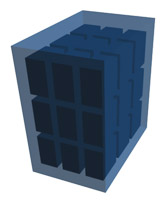Storage Challenges and Terminal Services Benefits
Many of the companies that adopt Virtualization architecture take the simple and seemingly straight forward approach that is VDI, or Virtual Desktop Infrastructure. This means that they simply create a Virtual Machine (VM) with a desktop Operating System (OS), such as Windows 7, and then present that VM to a client machine such as a thin client. This approach often appears to be the best move when converting users of standard PC and OS over to a virtual environment. What the user sees on the screen, and the actions they perform on the virtual machine, are nearly identical to what they have on the PC.
